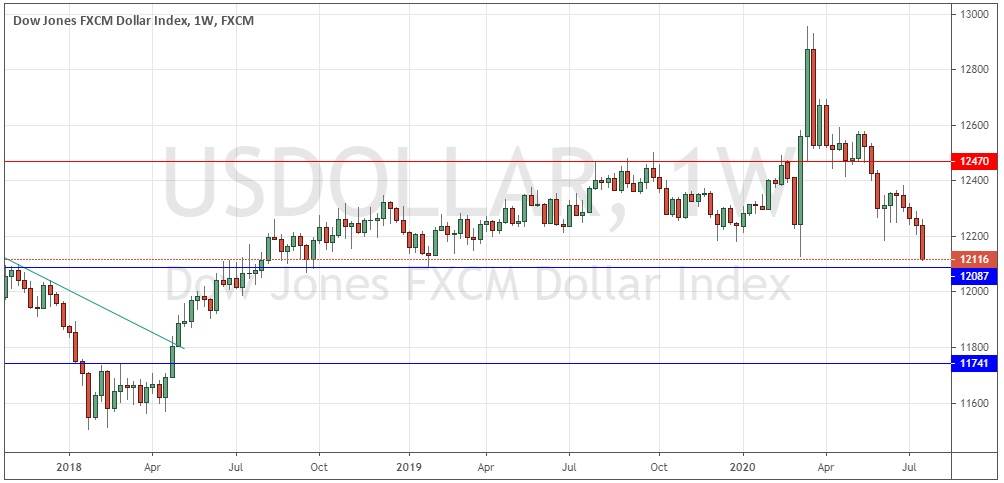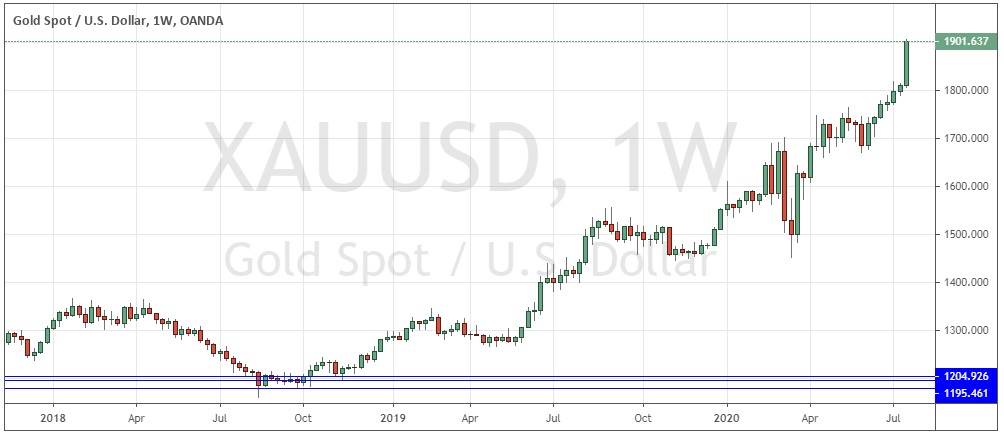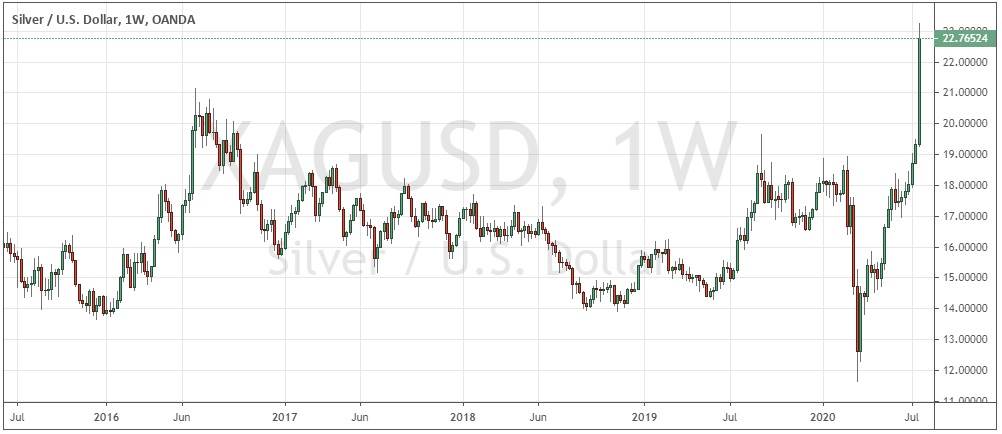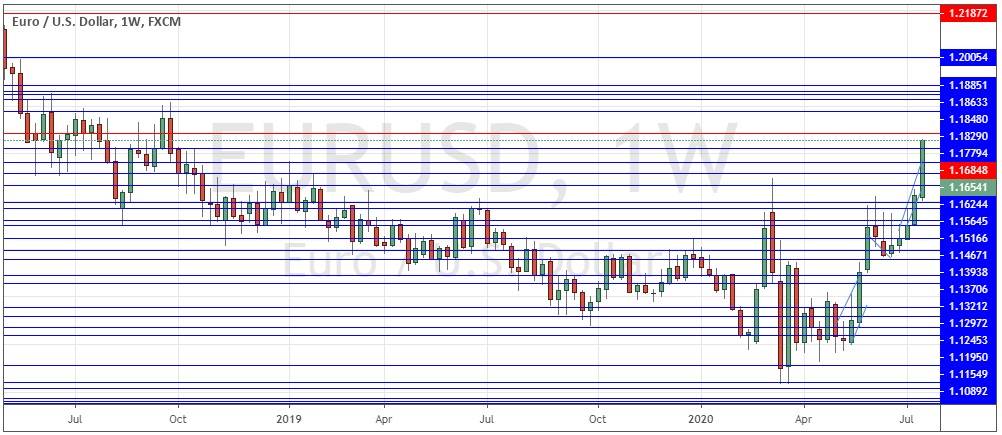The difference between success and failure in Forex trading is very likely to depend upon which currency pairs you choose to trade each week, and not on the exact trading methods you might use to determine trade entries and exits. The current market environment has changed from one of crisis to a questionable rebound, despite the continuing growth in the coronavirus pandemic which is still sweeping the world.
Big Picture 26th July 2020
In my previous piece last week, I saw the most attractive trade set-ups as likely to be long of Gold, Silver, the Euro, and the Swedish Krona in U.S. Dollars at half a unit each. This was a very profitable call, as Gold rose by 5.06% over the week, Silver by 17.79%, the Euro by 2.09%, and the Swedish Krona by 2.14%. This produced a very strong overall result for the week of a 13.55% portfolio gain.
Last week’s Forex market saw the strongest rise in the relative value of the Canadian Dollar and the strongest fall in the relative value of the U.S. Dollar.
Fundamental Analysis & Market Sentiment
The world is not coming to an end, but we are living in an extraordinary time of global health crisis, the magnitude of which has not been seen in over one hundred years. The vast majority of people are going to survive and be healthy, yet the impact of the crisis still dominates the global economy.
Last Friday saw daily new confirmed coronavirus cases hit a new all-time high just under 289,000 confirmed cases. This is a sign that globally, the wave of disease is still advancing to a peak.
We have seen the epicenter of the global coronavirus pandemic move into Latin America, with Brazil now seeing more new deaths from the virus than any other country in the world, and a higher total death toll than any country except the U.S.A. However, the U.S.A. is close behind, having reported more than 1,000 deaths for five consecutive days. The rolling averages of deaths have decreased significantly in Europe. However, the U.S.A. has seen a sharp increase in new cases over recent weeks to new all-time highs of over 75,000 cases per day, leading to rises in deaths in many states. Cases are also rising in Asia and Africa.
Latin America and the Caribbean are now responsible for approximately 45% of confirmed new daily deaths, with the U.S.A. at 15% and Europe at about 7%. The strongest growth in new confirmed cases is happening in Albania, Algeria, Argentina, Armenia, Australia, Bahamas, Bangladesh, Bosnia, Brazil, Bulgaria, Colombia, Costa Rica, Croatia, Ivory Coast, Czech Republic, Dominican Republic, Ecuador, Ethiopia, El Salvador, Georgia, India, Indonesia, Iran, Iraq, Israel, Japan, Kenya, Kosovo, Kuwait, Lebanon, Luxembourg, Mexico, Moldova, Morocco, Paraguay, Peru, Philippines, Poland, Romania, Serbia, South Africa, Spain, Ukraine, Uruguay, Uzbekistan, Venezuela, and the United States.
The U.S. stock market fell a little last week after breaking to a new high. The sector which had been doing the best lately, the NASDAQ 100 Index, fell more strongly.
The U.S. Dollar fell quite strongly last week, while precious metals rose very strongly. The rise in precious metals such as Gold and Silver and the renewed decline in U.S. treasury yields is leading to increasing pessimism over the state of the U.S. economy.
There is evidence that the coronavirus pandemic in the U.S. is peaking to a new crest in many states. New confirmed daily cases keep rising to hit new all-time daily high totals. There is increasing concern about the persistence of unemployment from earlier closures and restrictions and the economic impact of the reversals of easing which are now being imposed in several states.
The coming week will bring some very important releases concerning the USD: the central bank forecasts and GDP data. We will also get German and Canadian GDP data and Australian inflation data.
Technical Analysis
U.S. Dollar Index
The weekly price chart below shows last week printed a strongly bearish candlestick which closed right on its low – a bearish sign. This short-term price action is unquestionably bearish. There is finally a long-term bearish trend, as the price is lower than it was both 3 and 6 months ago. In fact, the weekly close is the lowest made in almost a year. The problem for bears is that the price is now close to the 12087 area which has provided support since early 2019, so a break below 12087 would be a significantly bearish technical development if it happens. Overall, next week’s price movement in the U.S. Dollar looks more likely to be downwards than upwards.
Gold
Last week printed a very large bullish candlestick which closed at a new 8-year high weekly closing price, after hitting a new 8-year high price. The closing price was only about $20 off the all-time high price of Gold in USD terms which was made in 2011. I again see that it is time to trade Gold in the long direction, as the signs point to higher prices still over the coming week.
Silver
Last week printed the largest bullish candlestick seen in many years, which closed at a new 6-year high weekly closing price. However, the price did close off the high of its weekly range after peaking on Wednesday. These are mostly bullish signs and other precious metals such as Gold are also advancing against the U.S. Dollar. There is a good chance that the price of Silver will rise over the coming week, but I am more optimistic about Gold.
EUR/USD
Last week saw this currency pair print a large, bullish candlestick which closed above 1.1650. This was the highest weekly close made here since September 2018. There is a long-term bullish trend and a weak Dollar. The price closed right at the top of its range, and the weekly candlestick was relatively very large. These are all bullish signs, and when the Euro moves on very above-average volatility, the movement has tended to continue.
This currency pair looks likely to rise further over the coming week.
Bottom Line
I again see the most attractive trade set-ups for this week as likely to be long of Gold and Silver in U.S. Dollar terms as each half of one unit, and long of EUR/USD as another unit.





